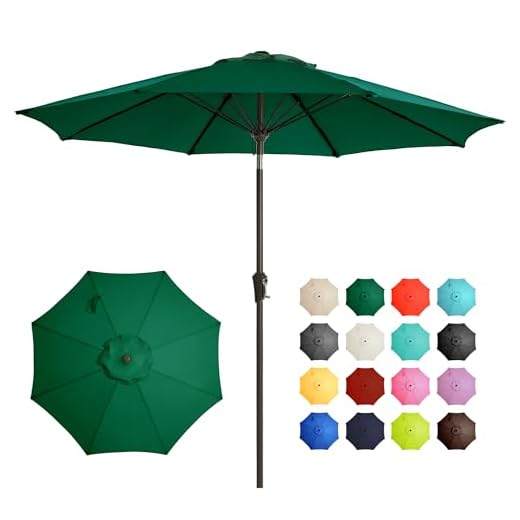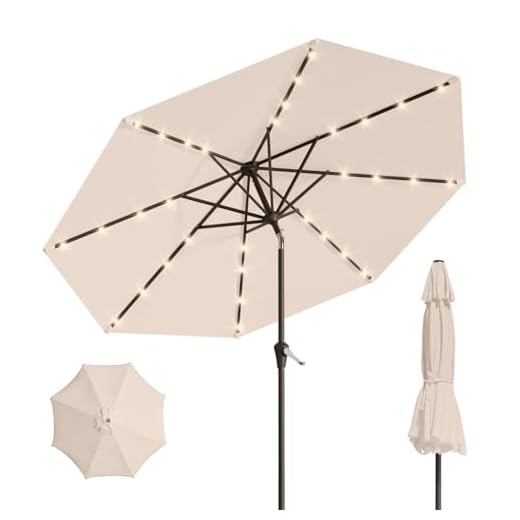




For optimal protection against harsh rays, look for fabrics like polyester and solution-dyed acrylic. These materials not only offer excellent UV resistance but also retain their color and shape over time, ensuring durability and longevity.
This article focuses on evaluating various textiles suitable for canopies, detailing their benefits and drawbacks. Homeowners, event planners, and outdoor enthusiasts will find this information particularly useful when selecting the right covering for their outdoor spaces.
We will explore characteristics such as UV protection, water resistance, and ease of maintenance. Additionally, we’ll provide tips on caring for these materials to extend their lifespan. By the end, you’ll be equipped with the knowledge to make an informed choice for your outdoor shading needs.
Best Material for Outdoor Umbrella for Shade from Sun
Polyester stands out as a highly recommended choice due to its UV resistance and durability. This synthetic fabric effectively blocks harmful rays while providing ample cover, making it ideal for prolonged outdoor use.
Another excellent option is solution-dyed acrylic, known for its colorfastness and water resistance. This material not only maintains its vibrant appearance over time but also withstands various weather conditions, ensuring long-lasting performance.
Key Benefits of Different Fabrics
- Polyester: Affordable and lightweight, offers decent UV protection.
- Solution-dyed Acrylic: Superior fade resistance, breathable, and easy to clean.
- Canvas: Thick and sturdy, provides excellent shade but may require more maintenance.
- Vinyl-coated Fabric: Highly resistant to moisture and mold, ideal for humid climates.
When selecting a cover, consider the following factors:
- UV Protection: Ensure the fabric offers sufficient UPF rating for effective sun shielding.
- Water Resistance: Look for materials that repel water to prevent damage during rain.
- Durability: Assess the fabric’s lifespan and ability to withstand wear and tear.
In summary, polyester and solution-dyed acrylic are among the most effective choices for outdoor structures aimed at providing relief from intense light exposure. Evaluating specific needs, such as climate and usage frequency, will guide the decision-making process.
Durability Factors: Choosing Long-Lasting Fabrics
When selecting fabrics, resilience against environmental conditions is paramount. Look for materials that can withstand UV rays, moisture, and varying temperatures without degrading quickly.
One crucial aspect is the fabric’s weave and thickness. A tighter weave not only provides better protection but also enhances longevity. Fabrics treated with UV inhibitors resist fading and deterioration over time.
Key Characteristics
- Water Resistance: Fabrics that repel water help prevent mold and mildew, extending their lifespan.
- Colorfastness: Choose colors that retain their vibrancy after prolonged sun exposure.
- Breathability: Well-ventilated materials reduce heat buildup, improving comfort and durability.
Additionally, consider the maintenance requirements. Some fabrics may need special cleaning agents, while others can be easily washed with mild soap and water.
Investing in quality can yield significant returns in terms of durability and performance. Evaluate the fabric’s warranty and care instructions to ensure it meets long-term expectations.
UV Protection: Evaluating Sun-Blocking Materials
Choosing the right fabric can significantly impact UV protection. Look for options that specifically mention UV resistance, as they are designed to block harmful rays effectively. These materials often undergo rigorous testing to determine their ability to shield against UV radiation.
Several characteristics can indicate the effectiveness of a fabric in blocking UV rays. Denier count, weave density, and chemical treatments all play crucial roles in performance. Fabrics with a higher denier count typically offer better durability and UV resistance. Additionally, tightly woven textiles can prevent sunlight from penetrating, enhancing protection.
Key Factors in UV-Blocking Fabrics
- Denier Count: Higher denier fabrics tend to be more durable and provide greater UV protection.
- Weave Type: A tighter weave can block more sunlight, affecting the level of shade provided.
- Coatings: Some textiles are treated with special coatings that enhance UV resistance.
Testing methods also vary, with some fabrics undergoing certifications to validate their UV-blocking capabilities. Look for items that specify their UV Protection Factor (UPF). A UPF rating of 30 or higher is recommended for effective sun protection.
Natural fibers, like cotton, may not provide significant UV shielding unless treated or blended with synthetic materials. Conversely, synthetic options such as polyester and acrylic generally offer better performance due to their inherent properties.
In summary, selecting the right fabric involves assessing denier count, weave density, and treatments that enhance UV protection. Understanding these elements can help ensure a more enjoyable and safer outdoor experience.
Water Resistance: Importance of Weatherproof Options
Choosing a shade solution that withstands various weather conditions is fundamental. Rain exposure can lead to deterioration and mold growth if materials are not adequately resistant. Weatherproof options significantly extend the lifespan of the product, ensuring consistent performance throughout the seasons.
Water-resistant fabrics create a barrier against moisture, keeping the interior dry and preventing damage. This feature is particularly beneficial for those who live in regions with unpredictable rainfall. Additionally, such options often require less maintenance, saving time and effort in the long run.
Benefits of Weatherproof Options
- Durability: Materials that resist water tend to last longer, reducing the need for frequent replacements.
- Maintenance: Regular cleaning is simplified, as moisture does not penetrate deeply.
- Comfort: A dry space enhances usability, allowing enjoyment even during light rain.
- Protection: Prevents the growth of mold and mildew, which can cause health issues.
Investing in weather-resistant solutions ensures reliable shade and comfort despite nature’s unpredictability. Prioritizing these features can lead to a more satisfying and prolonged experience.
Weight Considerations: Finding the Right Balance for Stability
Choosing the right weight is essential for ensuring stability in a sunshade structure. A balance between portability and sturdiness can prevent unwanted movement during windy conditions. It’s important to select a weight that anchors the support securely without making it cumbersome to relocate.
When assessing the appropriate weight, consider the size and height of the sun protection. Larger models often require heavier bases to withstand wind forces effectively. A weight of around 50-100 pounds typically provides the necessary support for larger installations, while smaller alternatives may only need 30-50 pounds.
Factors Influencing Weight Selection
- Wind Resistance: Evaluate the typical wind speeds in your area. Higher winds necessitate heavier bases.
- Material Composition: Different materials have varying weights. Concrete and steel are common choices for stability.
- Design Features: Some models incorporate innovative designs that enhance stability with lighter weights.
- Portability Needs: If frequent relocation is necessary, consider a lighter option with adequate stability features.
Ultimately, achieving stability requires evaluating environmental conditions and specific usage scenarios. A well-weighted support system not only enhances safety but also prolongs the lifespan of the sunshade, making thoughtful weight selection an integral part of the purchasing process.
Maintenance Ease: Selecting Fabrics for Simple Care
Opt for synthetic fibers like polyester or acrylic, which require minimal upkeep. These textiles resist fading and mildew, making them ideal for prolonged use in outdoor settings.
Regular cleaning is essential to prolong the lifespan of your canopy. Most fabrics can be washed with mild soap and water, ensuring they remain fresh and visually appealing.
Key Tips for Fabric Selection and Care
- Stain Resistance: Choose materials with stain-resistant coatings to simplify cleaning.
- Mildew Resistance: Look for water-repellent options that deter mold growth.
- Colorfastness: Ensure the fabric maintains its color over time, even with exposure to UV rays.
In summary, prioritize synthetic textiles that are easy to maintain, resistant to environmental factors, and require straightforward cleaning methods. By selecting the right fabric, you can enjoy comfortable outdoor spaces without the hassle of extensive care.
Best material for outdoor umbrella for shade from sun
Features
| Color | Green |
| Size | 9FT |
Features
| Part Number | 4336583223 |
| Model | 4336583223 |
| Color | TAN |
| Size | 9 FT |
Features
| Part Number | PULED10FTPKBG |
| Model | PULED10FTPKBG |
| Warranty | 2 Year Manufacturer |
| Color | Beige |
| Size | 10FT |
Features
| Part Number | FUB41B |
| Model | FUB41B |
| Color | Black |
| Release Date | 2023-12-22T00:00:01Z |
Video:
FAQ:
What is the best material for an outdoor umbrella to provide shade from the sun?
When selecting the best material for an outdoor umbrella, consider options like polyester, acrylic, and solution-dyed fabrics. Polyester is affordable and offers decent UV protection, but may fade over time. Acrylic is more durable and resistant to fading, making it a popular choice for outdoor use. Solution-dyed fabrics are specifically designed to withstand harsh sunlight, retaining color and strength for years. Each material has its pros and cons, so choose based on your budget, desired durability, and aesthetic preferences.
How do I maintain my outdoor umbrella to ensure it lasts longer?
To extend the life of your outdoor umbrella, regular maintenance is key. Start by cleaning the fabric with mild soap and water to remove dirt and stains. Make sure to rinse thoroughly and let it dry completely before storing. If your umbrella has a metal frame, inspect it regularly for rust or corrosion and apply a protective coating if needed. Additionally, when not in use, store the umbrella in a dry place or use a cover to protect it from the elements. Taking these steps can help keep your umbrella in good condition for many seasons.







